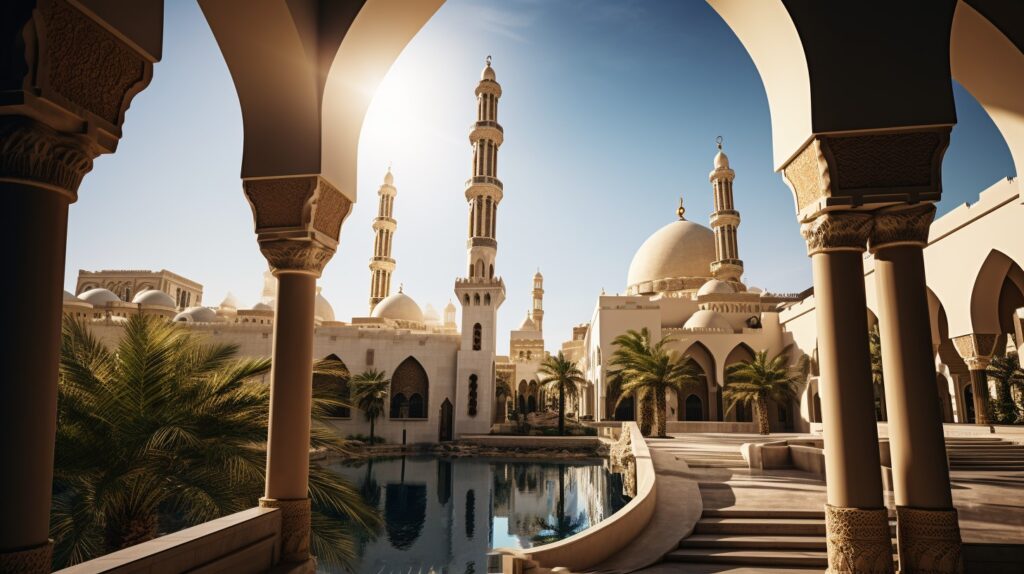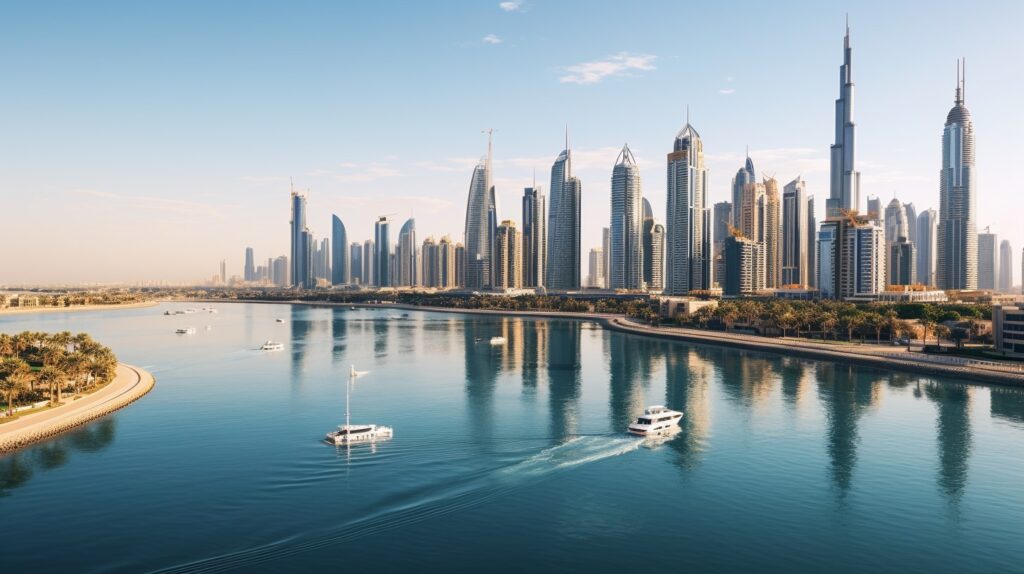Introduction
Dubai, a city that rose from the sands, has become a symbol of architectural ambition and innovation. This bustling metropolis, once a humble fishing village, now represents human ingenuity and vision. The city’s skyline, dotted with some of the world’s most stunning structures, tells a story of transformation and bold architectural endeavors. From traditional Bedouin tents to the towering Burj Khalifa, Dubai’s architectural journey is not just about buildings; it’s a narrative of culture, power, and aspirations. This article delves into the historical perspective of Dubai’s architectural wonders, exploring how each era contributed to the city’s unique skyline and global identity.
Early Architectural Influences
Traditional Bedouin Structures and Early Settlements: The roots of Dubai’s architecture lie in the simple yet functional structures of the Bedouin tribes. These nomadic people, who traversed the harsh desert landscape, built their homes from readily available materials. The traditional Bedouin tents, known for their adaptability to the desert climate, were the region’s early blueprints of architectural design. These structures were homes and a reflection of a lifestyle that valued mobility, simplicity, and harmony with nature.
Influence of Islamic and Middle Eastern Architecture: As Dubai evolved from a fishing village into a small trading port, the influence of Islamic and Middle Eastern architectural styles became evident. The construction of mosques and small fortresses marked the beginning of permanent settlement. The use of coral blocks, mud bricks, and palm fronds in these early buildings showed an adaptation to local materials and climatic conditions. The architecture of this period was characterized by courtyards, wind towers (Barajeel), and ornate wooden doors, reflecting the Islamic emphasis on privacy and environmental responsiveness.
The Birth of Modern Dubai
Discovery of Oil and Its Impact on Urban Development: The discovery of oil in the 1960s was a turning point in Dubai’s history. It marked the beginning of rapid economic growth and urban development. The newfound wealth from oil exports led to ambitious urban planning and the construction of modern infrastructure. This period saw the development of roads, ports, and the first high-rise buildings, laying the foundation for the modern city we see today.
The Shift from Traditional to Modern Architecture: As Dubai’s economy and population grew, it shifted from traditional architectural styles to more modern designs. It introduced air conditioning and new construction technologies, allowing for more creative and ambitious architectural projects. This era witnessed the construction of buildings that combined local architectural elements with modern Western styles, a blend that would define Dubai’s unique architectural identity.
Iconic Structures of the 20th Century
Development of Major Projects in the Late 1900s: The late 20th century was a period of significant development in Dubai. The city began to take on a more international character by constructing luxury hotels, commercial buildings, and residential complexes. Iconic structures such as the Dubai World Trade Centre, the tallest building in the Middle East when completed in 1979, symbolized Dubai’s growing ambition and global aspirations.

Key Buildings that Shaped Dubai’s Modern Skyline: The 1990s saw the emergence of critical buildings that would shape Dubai’s modern skyline. The Emirates Towers, completed in 2000, were among the first to reflect Dubai’s new architectural ethos, combining luxury, modernity, and a hint of traditional design. These towers set the stage for the architectural marvels that would follow in the next century.
The Millennium Boom
As the 20th century progressed to the 21st, Dubai’s skyline underwent a transformation that was nothing short of extraordinary. This period, often called the ‘Millennium Boom,’ saw an unprecedented surge in architectural projects that pushed the boundaries of design and engineering.
The Rapid Growth of Skyscrapers in the Early 2000s: The early 2000s marked the beginning of Dubai’s skyscraper boom. Fueled by a burgeoning economy and the desire to establish Dubai as a global city, developers embarked on ambitious projects to construct some of the world’s tallest and most innovative buildings. This era saw the rise of skyscrapers like the Burj Al Arab, which became a symbol of Dubai’s luxury and extravagance. Its unique sail-shaped design set it apart as an architectural marvel and a new icon for Dubai.
Introduction of Innovative Architectural Designs: This period was characterized by a willingness to experiment with bold and unconventional designs. The Jumeirah Beach Residence, a massive multi-tower development, offered a blend of residential and commercial spaces with a view of the Arabian Gulf. The Palm Islands, an audacious project, added a new dimension to Dubai’s coastline, creating the world’s largest artificial islands in the shape of palm trees. These projects were not just about making buildings but about reimagining what a city could be.
Architectural Icons of the 21st Century
The first two decades of the 21st century in Dubai were marked by the construction of architectural icons that garnered global attention and redefined the city’s identity.
Burj Khalifa and its Global Significance: The completion of the Burj Khalifa in 2010 was a milestone in Dubai’s architectural history. Standing at over 828 meters, it is the tallest building in the world, a title it still holds. The Burj Khalifa is more than just a feat of engineering; it symbolizes Dubai’s ambition and ability to turn dreams into reality. Inspired by the desert flower Hymenocallis, the building’s design blends cultural influences and cutting-edge technology, making it a beacon of modern Islamic architecture.

Other Landmark Buildings and Their Unique Features: Alongside the Burj Khalifa, other structures like the Cayan Tower, known for its twisting shape, and the Opus by Zaha Hadid, with its futuristic design, have contributed to Dubai’s reputation as a city of architectural wonders. With its dhow-shaped design, the Dubai Opera is a testament to the city’s growing cultural aspirations. Each building adds a unique story to Dubai’s architectural narrative, showcasing the city’s diverse influences and innovative spirit.
Sustainable Architecture and Future Trends
In recent years, Dubai has embraced the concept of sustainable architecture, recognizing the need for environmentally responsible and resource-efficient building practices.
Dubai’s Approach to Sustainable and Green Buildings: The city has implemented various initiatives to promote sustainability in architecture. The Dubai Green Building Regulations and Specifications, established in 2010, set standards for reducing the environmental impact of buildings. Developments like Sustainable City and Masdar City are examples of Dubai’s commitment to sustainability, featuring renewable energy, green spaces, and water conservation systems.
Predictions for Future Architectural Trends in Dubai: Looking to the future, Dubai is poised to continue its journey of architectural innovation. The trend towards sustainability is expected to grow, emphasizing buildings that are aesthetically pleasing and environmentally conscious. The use of technology in architecture is likely to increase, with intelligent buildings that optimize energy use and provide enhanced living experiences. Dubai’s architecture is set to evolve to reflect the city’s status as a hub of innovation, luxury, and sustainability.
Cultural and Artistic Influence on Architecture
Dubai’s architecture is not only a reflection of economic and technological advancements but also a canvas for cultural and artistic expression.
The Role of Cultural and Artistic Movements in Shaping Architecture: Various cultural and artistic movements have influenced the city’s architecture. Traditional Islamic art and architecture play a significant role, incorporating motifs and design principles into modern buildings. The use of calligraphy, geometric patterns, and traditional Islamic architectural elements like arches and domes are examples of this influence.
Examples of Culturally Inspired Architectural Projects: Projects like the Dubai Frame, which offers panoramic views of the old and new Dubai, symbolize the city’s journey from a humble past to a futuristic present. With its calligraphy-covered facade, the Museum of the Future is another example of how Dubai’s architecture melds art, culture, and technology. These structures are not just buildings but embody Dubai’s cultural identity and artistic aspirations.
